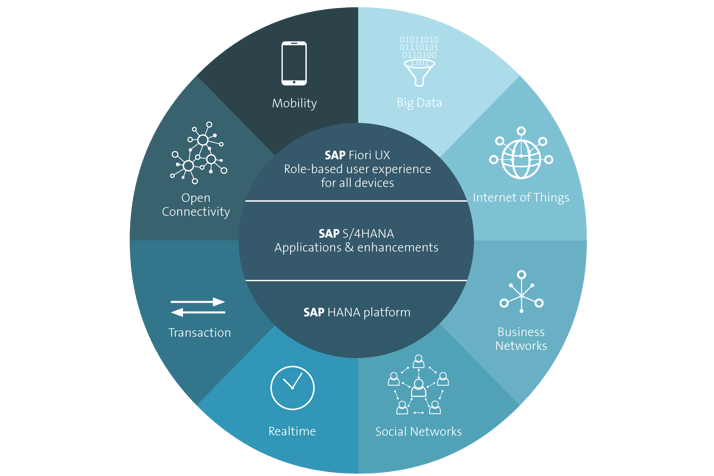What is SAP S/4 HANA?
SAP S/4HANA, crafted by SAP SE, is an enterprise resource planning software tailored for large-scale enterprises. It serves as the evolutionary progression from SAP R/3 and SAP ERP, designed specifically to leverage SAP's in-memory database technology, SAP HANA.
Purpose
SAP S/4HANA is an enterprise resource planning (ERP) software package meant to cover all day-to-day processes of an enterprise (for example, order-to-cash, procure-to-pay, plan-to-product, and request-to-service) and core capabilities. It integrates functions from lines of businesses as well as industry solutions, and also re-integrates portions of SAP Business Suite products such as SAP SRM, SAP CRM and SAP SCM. As SAP Business Suite 4 only runs on the SAP HANA database it is packaged as one product: SAP S/4HANA. SAP's classical R3, ERP and ECC based business suite and related products were designed to run on several database platforms, including those from Oracle, Microsoft and IBM.
History
The SAP HANA platform has been available since 2010, and SAP applications like SAP ERP and the SAP Business Suite are able to run on the SAP HANA database and/or other supported database systems.
The new suite, SAP S/4HANA, launched on 3 February 2015 at the New York Stock Exchange. The event introduced cloud and on premises editions, with the on-premises edition becoming available on the same day. The cloud edition went live at SAPPHIRE NOW (SAP’s annual customer conference) on 6 May 2015 in Orlando, Florida.
SAP S/4HANA was called SAP's biggest update to its ERP strategy and platform in over two decades. Post-launch, Gartner analysts noted that SAP S/4HANA represented a "transformational shift," but raised questions about functionality, availability, pricing and migration issues surrounding S/4HANA.
By 21 April 2015, 370 customers had purchased S/4HANA. After the first half of 2015, positive growth was confirmed for SAP. During the third quarter earning calls that took place in October 2015, SAP confirmed that S/4HANA had more than 1,300 customers. By the end of Q4 2016, SAP announced that 5,400 customers had implemented SAP S/4HANA, growing to 8,900 customers by 30 June 2018.
Editions
SAP S/4HANA can be deployed on-premises, in the cloud, or through a hybrid model. The S/4HANA product offering consists of various editions: SAP S/4HANA Cloud: previously called essentials edition (ES) and Multi-Tenant Edition, SAP S/4HANA Cloud extended edition: previously called Single-Tenant Edition, SAP S/4HANA Cloud, private edition, SAP S/4HANA On-Premise.
SAP S/4HANA On-Premise is similar in terms of coverage, functionality, industry-specific support, and localization to the current SAP Business Suite (in 39 languages, 64 country versions).
SAP also offers SAP S/4HANA Cloud (in 18 languages, 33 country versions). SAP has emphasized the product as pivotal to its cloud shift.
Both editions consist of functionality for finance, accounting, controlling, procurement, sales, manufacturing, plant maintenance, project system, and product lifecycle management, plus integration with SAP SuccessFactors, SAP Ariba, SAP Hybris, SAP Fieldglass and SAP Concur.
Implementation
There are various ways to get to S/4HANA. This depends on a customer’s starting point. For example, new implementation, system conversion, and selective data transition.
New implementation - This is a new implementation of SAP S/4HANA ("Greenfield"): Customers who are migrating from a non-SAP legacy system or from an SAP ERP system and implementing a fresh system that requires an initial data load. In this scenario, the SAP S/4HANA system is implemented, and master and transactional data are migrated from the legacy system, thus standard data migration tools and content has to be used.
System conversion - This is a complete conversion of an existing SAP Business Suite system to SAP S/4HANA ("Brownfield"): Customers who want to change their current SAP ERP system to SAP S/4HANA. This scenario is technically based on Software Update Manager (SUM) with Database Migration Option (DMO) in case the customer is not yet on SAP HANA as the underlying database. Nowadays, companies prefer the brownfield method (system conversion).
Selective Data Transition (formerly: Landscape Transformation) - This is a consolidation of current regional SAP systems into one global SAP S/4HANA system or a split out of different parts of a system:
Customers who want to consolidate their landscape or carve out selected entities (such as a company code) or processes into a single SAP S/4HANA system.



